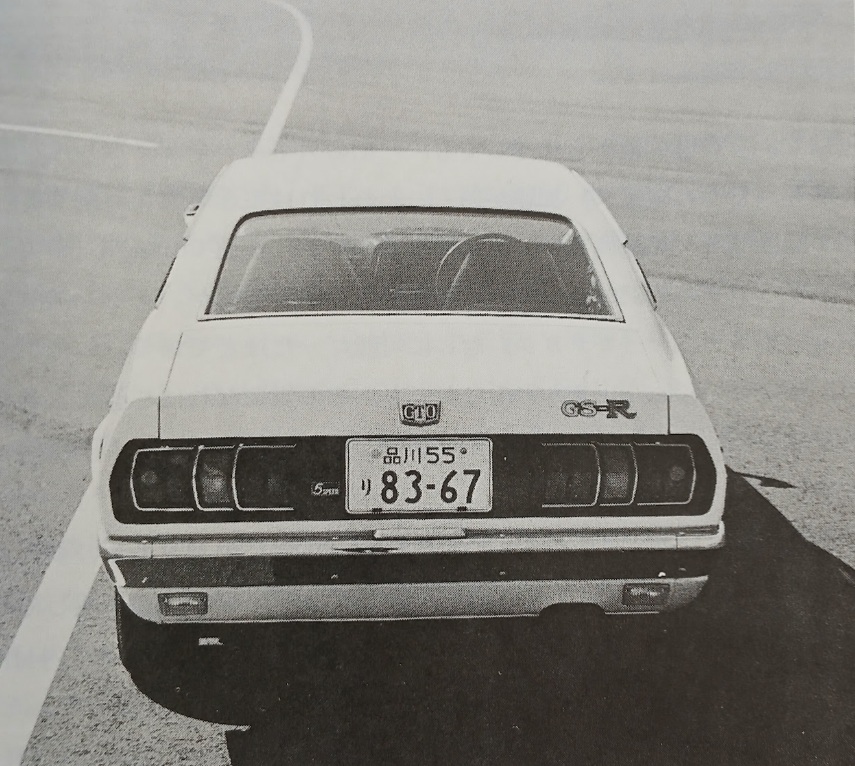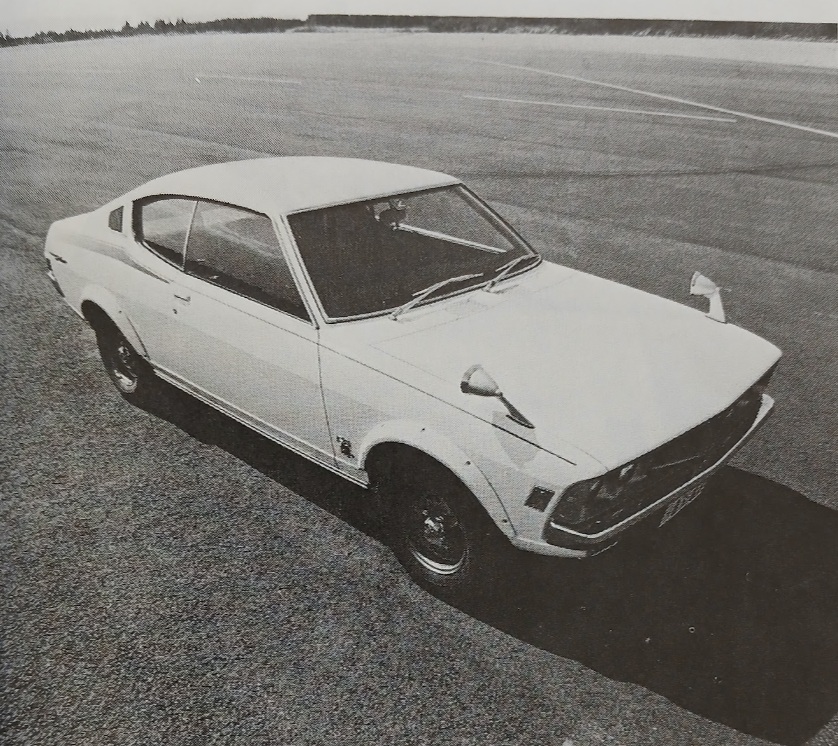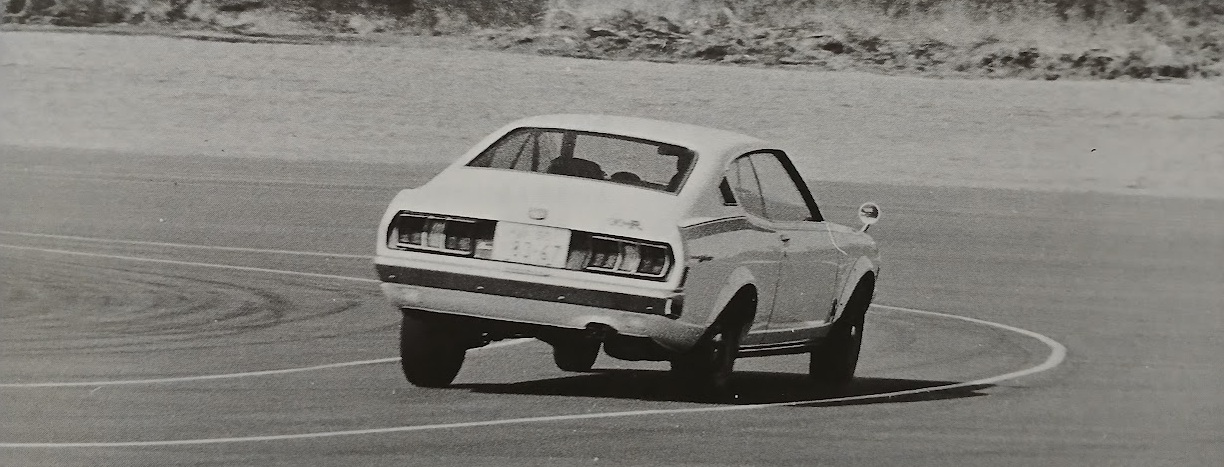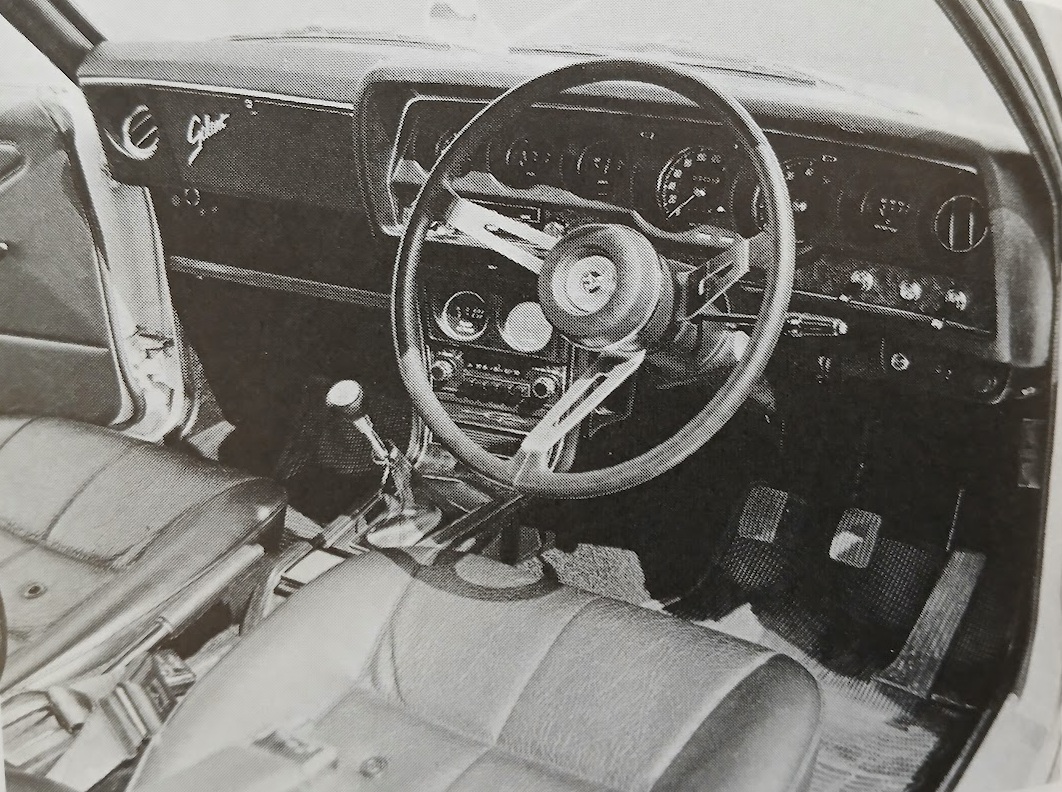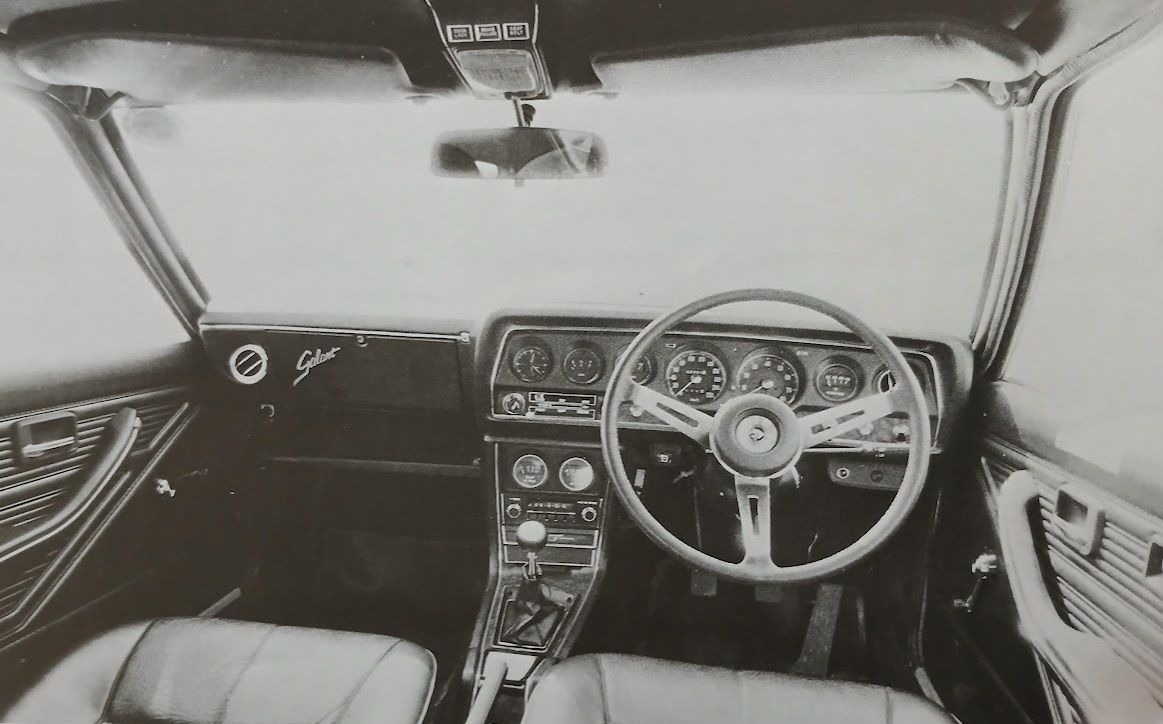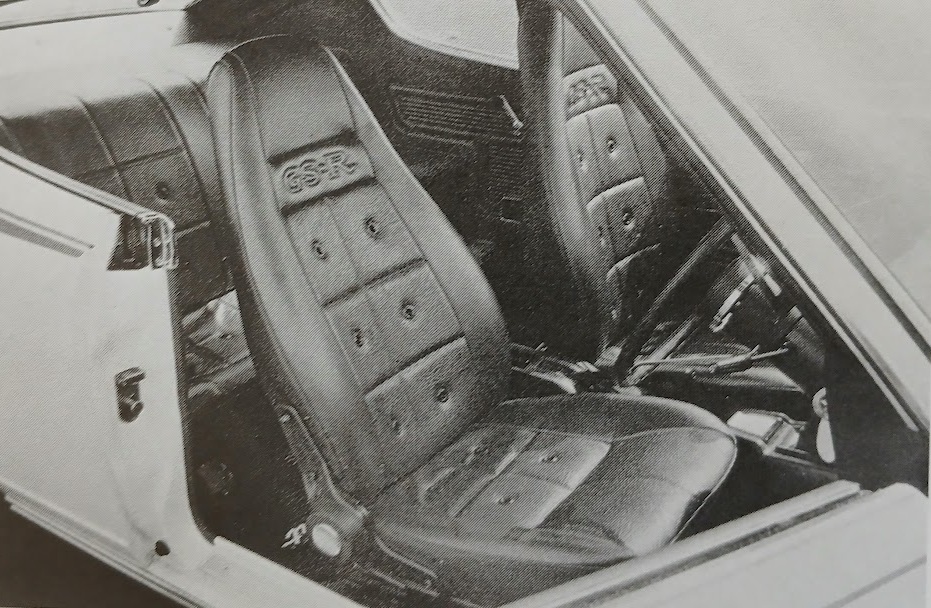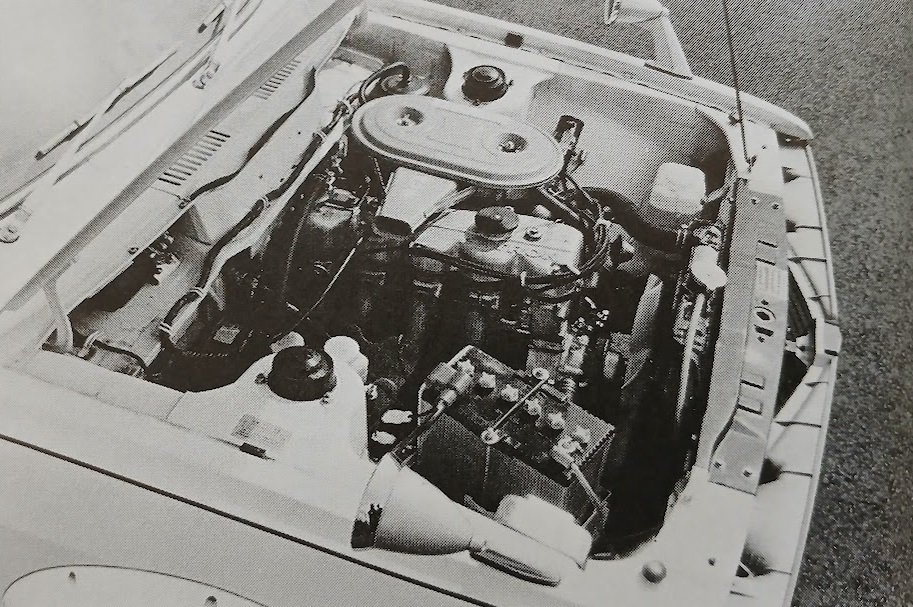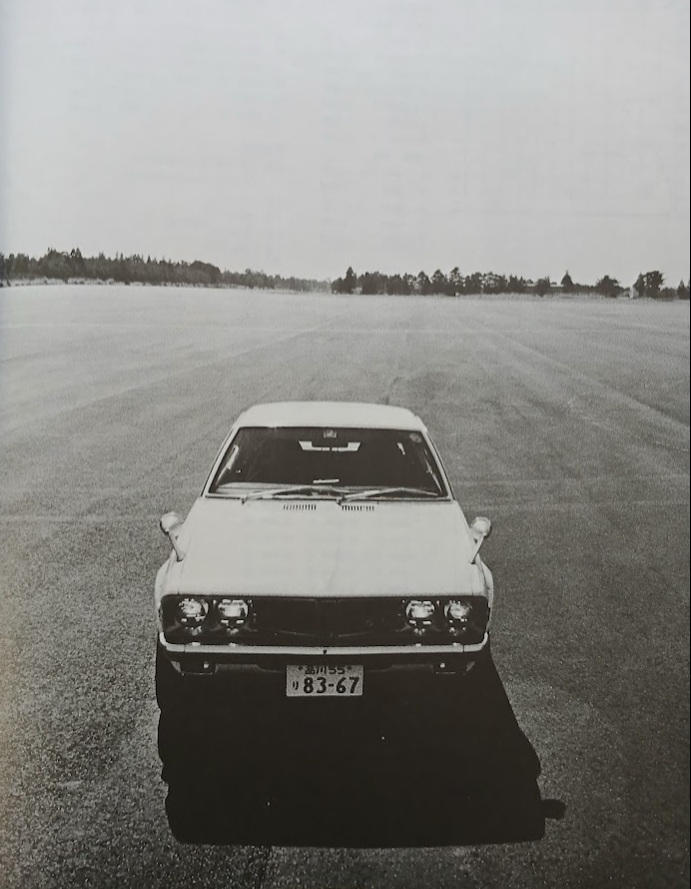Mitsubishi Colt Galant GTO 2000GSR (1973)
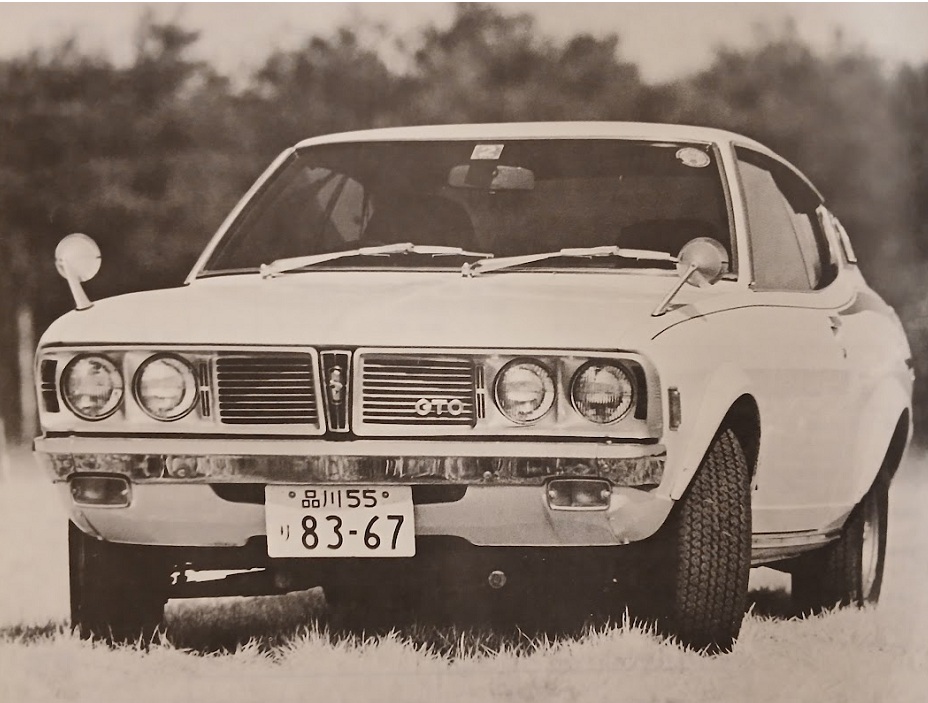
Publication: Car Graphic
Format: Road Test
Date: May 1973
Author: “C/G Test Group” (uncredited)
Summary: Engine enlarged to 2 liters and 125ps, good low- and mid-range torque, easy to use around town, acceleration performance surpasses that of DOHC 1.6-liter MR except at highway speeds. Excellent 5-speed gearbox. Fifth gear can be used often, good fuel economy on the highway, average maneuverability despite 5J rims and 185/70R-13 radials, brake force greatly reduced, good seats.
Road testing the Mitsubishi Galant GTO 2000GSR
The Galant GTO, which has been a hit with its cleverly scaled-down Ford Mustang-like styling, had its engine enlarged and strengthened to 2 liters for 1973, and was renamed the GTO 2000. The new 2-liter “Astron” engine is basically the same design as the existing 1.7-liter “Saturn,” with a SOHC hemispherical combustion chamber, long stroke (84mm x 90mm), and a displacement of 1995cc, and comes in two types of tune with differences in compression ratio and carburetion. There are five models in the GTO 2000 series: the GSR and GS-5 have an engine output of 125ps/6200rpm, while the SL-5, SL Automatic, and SL are rated at 115ps/6000rpm. There are three types of transmission, 5-speed, 4-speed, and Borg-Warner automatic, but the 125ps GSR and GS-5 models are only available with the 5-speed. Of the previous XI and II models, only the single-carburetor 105ps type was retained, and with minor improvements, has become the 1700SL/SL-5 (the latter is newly equipped with a 5-speed gearbox).
The model we tested was the GSR (943,000 yen), the sportiest of the GTO 2000 series. Aside from the engine, improvements common to all GTO models include an increase in wheel rim width from 4.5J to 5J and a strengthened brake servo. Only the GSR comes standard with 185/70HR-13 tires, and has FRP overfenders on the front and rear to accommodate the wider tires.
Since the 1.6-liter DOHC GTO MR was discontinued last year, this SOHC 2-liter GSR is now the most powerful GTO, so we would like to write our impressions mainly by comparing it with the MR. First, let’s compare the specs of the two cars. The body is exactly the same except for small details, but the GSR is 35kg heavier at 1015kg. The engine of the MR was a DOHC 1597cc unit with a maximum output of 125ps/6800rpm, while the GSR is SOHC with 125ps/6200rpm. Therefore, the GSR is at a slight disadvantage in terms of power-to-weight ratio, at 8.1kg/ps compared to the MR’s 7.8kg/ps. However, although the output is the same, the torque has been greatly increased, with the MR at 14.5kgm/5000rpm and the 2-liter GSR at 17.5kgm/4200rpm. It is torque rather than power that determines acceleration performance, and test results showed that the acceleration performance of the 2-liter GSR was generally significantly better than that of the 1.6-liter MR. On the other hand, at top speed, it is still the power output in the high-speed range that matters, with the MR having the advantage. To be specific, the GSR was quicker in 0-400m acceleration, 16.1 seconds compared to the MR’s 16.3 seconds, while the MR was faster in top speed, 182km/h at 6050rpm compared to the GSR’s 178km/h at 5400rpm.
Galant-type SOHC engines, even those with a single carburetor, are known for being very smooth and easy to rev up to high revolutions, and the Astron, even at 2 liters, is no exception. The rev counter is redlined from 6000-8000rpm, but it can easily rev up to 7000rpm. However, once it exceeds 6500rpm, the power drops off rapidly, so during acceleration tests, we found that the best time was achieved by shifting up at 6500rpm. In the DOHC MR, the redline is 7200-8000rpm, and in fact it was possible to regularly use over 7000rpm. Compared to the MR, the GSR engine has a slightly lower upper limit of the revolution range, but this is somewhat compensated for by raising the final drive ratio (from 4.22 to 3.89). In other words, in terms of the overall gear ratio, taking into account the tire diameter, the GSR is higher geared (the speed per 1000rpm in fourth gear is 27.6km/h, compared to 25.6km/h for the MR). It is only natural that the GSR’s top speed is lower than that of the MR, considering that it has the same power output, is slightly heavier, and has a slightly higher gear ratio. However, the top speed in the direct-drive fourth gear remains the same, at 166km/h for both the MR (where it is reached at 6500rpm) and the GSR (6000rpm).
When the MR first appeared, it was the only model in the Galant series with a 5-speed gearbox, so the gear ratios were chosen specifically to match the power characteristics of the DOHC engine, and were quite close together. However, when the 1400 was later equipped with a 5-speed, the gear ratios were modified to suit a more docile power unit, and the gap between third and fourth gears in particular was increased. In the current Galant range, from the 14L SL-5 to the 2-liter GTO 2000GSR, the same common gear ratios are used in the 5-speed gearbox of all types. Specifically, the gear ratios are 3.238 / 1.955 / 1.341 / 1.000 / 0.854, compared to the MR’s 3.197 / 2.043 / 1.273 / 1.000 / 0.845.
The new gearbox matches well with the output of this 2-liter engine and its wide, flat power characteristics. When accelerating to 6000rpm in second gear and shifting up, the engine speed drops to 4200rpm; when shifting from third to fourth, the engine speed drops to 4500rpm; and when shifting from fourth to fifth, the tachometer needle drops to 5000rpm. In all cases, the acceleration is powerful and right within the power band where the strongest torque is obtained. However, compared to the MR’s 5-speed gearbox, the speed increase in third gear is significantly suppressed in terms of both gear ratio and rpm. In other words, while the MR can reach 145km/h at 7200rpm in third gear, the GSR can reach 122km/h with a rev limit of 6000rpm, and can only reach 132km/h when pushed past the redline to 6500rpm. Apart from this, this 5-speed gearbox is one of the best, even from an international perspective. The shift stroke is short and precise, and it is light and extremely easy to handle.
The GSR does not have the torque rod that was added to the rear axle of the MR, but rear axle tramp (a phenomenon in which the rear axle flails wildly under load) during sudden acceleration did not occur unless the clutch was operated very suddenly (acceleration times were slowed down due to excessive wheelspin).
Generally, there is power to spare, and when driving on expressways such as the Tomei Expressway, you can leave it in fifth gear the whole time, and it is still possible to climb hills and overtake. If you are blocked by a slow truck and are forced to slow down, you can actually shift down from fifth to third gear, skipping one gear and overtaking in one go.
Despite the compression ratio of 9.5, this engine is surprisingly strong at low speeds. 30km/h in fifth gear is about 1000rpm, but even when accelerating from this low speed, there is no knocking at all, and the acceleration is smooth (and, of course, slow). This was most clearly demonstrated during our fuel consumption tests. To measure fuel consumption, we drive at a constant speed for 1km, and it was possible to drive the GSR at this incredibly low speed of 30km/h in fifth gear (effectively idling at 850rpm) without any transmission snatch. Therefore, even in the city where the speed limit is 60km/h, you can put it in fifth gear if you want to, making it extremely easy to use in urban areas for such a sporty car.
As mentioned above, the GSR’s standing-start acceleration is faster than the 1.6-liter DOHC MR, but when it comes to overtaking acceleration, measured by accelerating rapidly from a constant speed, the MR is generally faster for some reason. Acceleration times from 60-100km/h in third, fourth, and fifth gears for the GSR and MR (in parentheses) were 6.7 seconds (6.2), 9.5 seconds (8.6), and 11.0 seconds (11.5). From 80-120km/h, the times were 8.0 seconds (6.5), 10.2 seconds (8.9), and 12.2 seconds (13.2).
The MR’s close-ratio gearbox is thought to be the reason for the large difference between the MR and GSR in the 60-100km/h and 80-120km/h times in third and fourth gear. On the other hand, the GSR’s advantage in fifth gear acceleration must be due to the absolute difference in torque. But it is puzzling that the torque difference between the two cars is not apparent in third and fourth gears. A possible reason for this is the difference in carburetor characteristics. The MR uses two Mikuni Solex carburetors with sharp throttle response (and “dirty” exhaust gases), while the GSR uses two Stromberg two-barrels, which are set as lean as possible to suppress exhaust gases.
As for fuel economy, the advantage of the two-barrel carburetor is that the constant speed fuel economy up to around 80km/h, where only the primary side is active, is exceptionally good for a 2-liter twin-carburetor engine. The best fuel economy is achieved at 50km/h in both fourth and fifth gear, recording 15.9km/l and 18.2km/l respectively. It is particularly notable that there is almost no difference in fuel economy between 30 and 60km/h. Comparing fuel economy data at 100km/h, the GSR is 11.8km/l (12.4km/l in fifth gear) while the MR is 11.3km/l (12.3km/l in fifth gear), so the 2-liter type is slightly better.
Due to various reasons, the total distance covered in this test was short (369km) and most of the fuel economy measurement was done at Yatabe, so the average practical fuel economy was only 7.5km/l. The MR averaged 7.7km/l when measured over a wider variety of road conditions, so the GSR should at least be better than this. The compression ratio is 9.5 and premium gasoline is required. For some reason, the fuel tank is smaller at 52 liters compared to the MR’s 55 liters.
Regarding the chassis, one of the improvements common to the 1973 GTO series was the increase in the diameter of the brake servo from 4.5 inches to 6 inches, reducing the brake pedal force required. The effect of this is so pronounced that it is immediately obvious. In the previous GTO, unless you opened the hood to check, you would have thought it did not have a servo because of the incredible amount of brake pedal force required. To give some numerical values, the MR required 20kg of pedal force to decelerate at 0.5g, where the same pedal force results in a deceleration of 0.77g in the GSR. When we simulated a panic stop (about 25kg of pedal force), the rear wheels did not lock due to the pressure control valve, while the front wheels locked for about 5m, but directional stability was unaffected.
The results of the 0-100-0 fade test were that the initial pedal pressure of 12kg for the first stop increased with each subsequent stop, reaching 18kg on the fifth stop and 28kg on the tenth. From the sixth stop onwards, smoke and smell from the pads was noticeable, and fade was definitely present as the pedal pressure increased. This test is very harsh, and there are very few opportunities to subject the brakes to such hard use in real-world driving. Nevertheless, we include it as an important item in the C/G road test because, unfortunately, the braking performance of Japanese cars is still far behind international standards, and we hope that domestic automakers will catch up to the average level as soon as possible.
The original GTO, which was released in the fall of 1970, was fitted with narrow 155SR-13 tires on 4J x 13 rims. C/G had been criticizing narrow rims and poor tires as a common weakness of domestic cars for ten years by then, but with the appearance of the MR, the rims and tires were upgraded to 4.5J x 13 and 165SR-13, and from 1973, 5J rims were adopted for all GTO models. Only the high-performance GSR is equipped with 185/70HR-13 radials as standard, and FRP overfenders are added to clear this fat tire. The test car had Yokohama GT Special Super 70s. But, to be honest, we didn’t think the handling has noticeably improved. It’s not bad by any means, but rather, it is neither above nor below the average level for domestic sports cars. At a minimum, we didn’t sense a real benefit from the rims being widened to 5J and tires to 185-width, unfortunately. Instead, only the negative aspects were observed, such as an overall increase in steering force, and interference in tracking due to unevenness in the road surface (the so-called “wander” phenomenon), which is particularly noticeable at low speeds on city streets.
All GTO models are equipped with recirculating-ball steering with a variable ratio (15.5:1 when going straight, 18.1:1 near full lock). In the MR, steering response was sharp by Japanese car standards, with mild understeer within a desirable range, but the GSR has taken a step back, with stronger understeer and an overall duller impression.
At normal cornering speeds, the understeer is within a reasonable range, there is little roll, and apart from the steering force, which is generally not light, the car follows the steering quite obediently. However, cornering at the limit, such as in a slalom, is greatly spoiled by the performance of the tires. The absolute grip is low for a 185/70HR-13 tire, they squeal easily, and the understeer is excessive. The steel-belted radial tires recently released by Yokohama show high grip levels, close to that of the Michelin ZX, so we thought that if they were replaced with these, the 5J rims would also be able to be used to greater effect, but the currently used 185/70HR-13 is a rather “soft” radial, and is therefore relatively insensitive or “squishy” when going over small irregularities in the road surface. The suspension is clearly designed for high speeds, but even at low speeds, it provides a flat and comfortable ride, probably due to the same “soft” radials. Of course, the ride is hard in absolute terms, but although it is firm, it is by no means harsh. The hardtop coupe body is highly rigid, and it hardly creaks even on rough roads, giving the impression of being well-built.
The only thing that has been changed in the interior is the seat material. Previously, the center part of the seat that supports the body was upholstered in fabric, but now the seats are entirely made of vinyl leather. The high-back front seats with integrated headrests are very good, and the body’s pressure points are well supported. Only the GSR has perforated holes for ventilation in the cushion and backrest. The fore-and-aft seat adjustment offers a lot of travel, and combined with the tilt steering wheel (best in the lowest position) that is a feature of the Galant series, you can sit comfortably with your arms and legs fully extended. The steering wheel rim is too thin to steer such a sporty car properly, tiring your fingers. A thick leather-wrapped rim is available as an option.
The dashboard is packed with everything you need: speedometer, tachometer, water temperature, ammeter, fuel gauge, clock, and even an oil pressure and oil temperature gauge in the center console (incidentally, the oil temperature only rose to 100°C when reaching top speed at Yatabe). The design of the gauges is clean and pleasing, but the scales on the speedometer and tachometer are a little too fine. They would be easier to read if their diameter was increased or the tips of the needles were painted red. Apart from the light on/off switch, the only switch we used often was the useful multi-function lever on the right side of the steering column, which operates everything the driver needs: high/low beams, flasher, turn signals, wipers, and washers. It is unusual these days that the horn button is still in the center of the steering wheel; we think it should be moved to the spokes.
The GTO is the first Japanese car to have what is called an overhead console. It has an extremely bright interior light and three warning lights for seat belts, brake failure, and door locks. Accessories are particularly plentiful among domestic cars, and a heat-printed rear window, heat-resistant glass, and wipers with fins are standard, although the radio is AM only. Furthermore, on the 1973 model, the radio antenna was redesigned to be part of the trunk lid itself rather than using an aerial for reception.
The rear seats are lowered like in the Alfa GTV, and are large enough to seat two people comfortably, or three if you’re really trying. The backrest is closer to vertical than that of a sedan, and in this respect, the Celica GT is more comfortable for rear seat passengers.
There is nothing more that needs to be added to the complete set of accessories, but the option list includes an air conditioner, power windows, stereo speakers, rear seat belts, etc. The finish inside and outside is generally among the better domestic cars, far surpassing international standards.
The price is 943,000 yen, which is much cheaper than the previous DOHC 1.6-liter MR (1,125,000 yen). The relationship between the GSR and MR is similar to that between the Porsche 914/2.0S and the discontinued six-cylinder 914/6. If you don’t hear the engine sound, you can’t tell the difference between the two cars from the outside, and the 914/2.0S is actually faster than the 914/6 in terms of standing-start acceleration. The 914/6 is superior only in terms of top speed and acceleration performance at higher speeds, and the price was 50% higher. The same can be said about the GSR and MR, but since there is less difference in performance than in the case of the Porsches, the GSR can be said to be an even better deal.
Postscript: Story Photos

